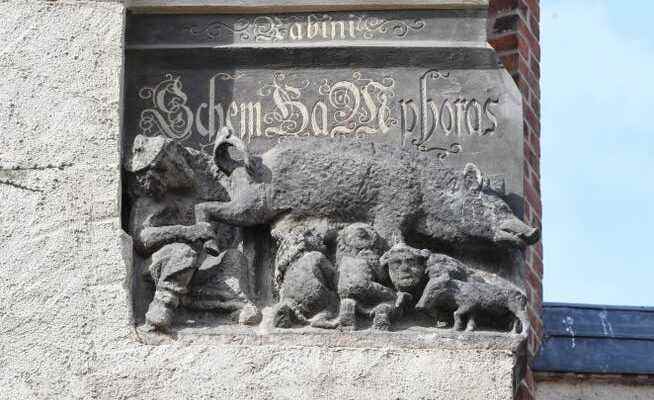The process of an anti-Jewish pig relief at the Wittenberg town church has been decided. The plaintiff, a convert, wants to continue suing. Years ago, the Jewish community had approved the whereabouts of the work.
The anti-Semitic relief on the town church in Wittenberg is quite small and hangs high up, it is part of a memorial and is a listed building. A plaintiff has been fighting it for years, so far in vain.
Dietrich Düllmann is not enough. In 1968, as a theology student, he had himself locked in the Marienkirche in Wolfenbüttel with an ax in order to destroy memorial plaques for those who died in World War I. For this he went to court and was convicted. Ten years after the destruction, he converted to Judaism and has been using his first name Michael ever since. Düllmann is now 79 and still recalcitrant. He has been persistently pursuing his current mission for years: he wants an anti-Semitic relief to disappear from the town church in the “Lutherstadt” Wittenberg. However, the Federal Court of Justice dismissed his lawsuit in the third instance on Tuesday.
The work is almost 800 years old. It shows a sow suckling Jews from the teats while a rabbi looks into the animal’s anus from behind. The controversial work of art is quite small – about 50 by 120 centimeters – and hangs four meters above the ground under the ridge of the roof of the church, which itself is a listed building and a Unesco World Heritage Site.
When Martin Luther published the anti-Judaist writings “Of the Jews and their lies” and “Of the Shem Hamphoras and the sex of Christ” in 1543, the sculpture had been hanging for 250 years. The inscription “Rabini Shem Ha Mphoras” was added in 1570, based on Luther.
The Jewish community was also in favor of being left hanging
As part of renovation work, the parish church council decided in 1983 to leave the relief in place. This decision was made together with the Jewish community.
Since 1988, the “Judensau” has also been part of a memorial consisting of a floor slab and an explanatory plaque in front of the church wall. It was unveiled in November 1988, fifty years after the beginning of the pogroms against Jews in Nazi-ruled Germany. The base plate, cast in bronze, shows four tread plates tilted against each other, which look as if they were laid in muddy ground. The joints form a sign of the cross. The surrounding text connects the inscription on the abusive sculpture with the Holocaust: “God’s real name / the reviled Shem Ha Mphoras / whom the Jews before the Christians / held almost unspeakably holy / died in six million Jews / under a sign of the cross.”
On the explanatory panel on the church it says that abusive sculptures of this kind were particularly widespread in the Middle Ages. About fifty such sculptures still existed. There are similar works with a “Judensau” motif in other German and European churches, including the Cologne Cathedral.
The plaintiff’s rights have not been violated
Düllmann sees the Wittenberg plant as an insult and has complained about it. The district court of Dessau-Rosslau dismissed the lawsuit in May 2019, reasoning: the plaintiff has no right to removal, because leaving the sandstone relief from the 13th century in connection with a memorial created for this purpose at a listed World Heritage Site does not constitute an insult from which a claim for removal could be derived. The Higher Regional Court of Naumburg saw this in February 2020 as well. It dealt with the work in detail. The relief was allowed to remain; Düllmann went before the Federal Court of Justice. He had nothing to complain about in the assessment of the lower courts.
According to the court, Düllmann is entitled to take legal action against the content of the relief. Viewed in isolation, the relief mocks and denigrates Judaism as a whole. Such a representation also directly attacks the claim to validity and respect of every Jew living in Germany, because “this group of people has been united by the National Socialist genocide, which allows them to stand out from the general public”.
And yes, the relief itself is “anti-Semitism set in stone”, as the presiding judge Stephan Seiters put it during the hearing on May 30 in Karlsruhe. But the infringing situation that existed until November 11, 1988 was eliminated by the obvious embedding, the “shame” changed into a memorial. Embedding in such a memorial also means giving future generations illustrative examples of past anti-Semitism.
The disposal of the past
The lawyer for the parish, Brunhilde Ackermann, was satisfied with the verdict. “The importance of this decision goes beyond the case,” Ackermann told the NZZ. “How do we deal with the past, even if it is highly discriminatory and offensive: do we deal with it and try to clarify it so that it doesn’t happen again, or do we remove and dispose of the past?” This discussion also exists in other areas, such as colonialism and literary works. One shouldn’t sacrifice the critical appraisal on the altar of the zeitgeist, but rather face the past.
Michael Düllmann had already expected this outcome of the proceedings. Next he wants to go before the Federal Constitutional Court.
